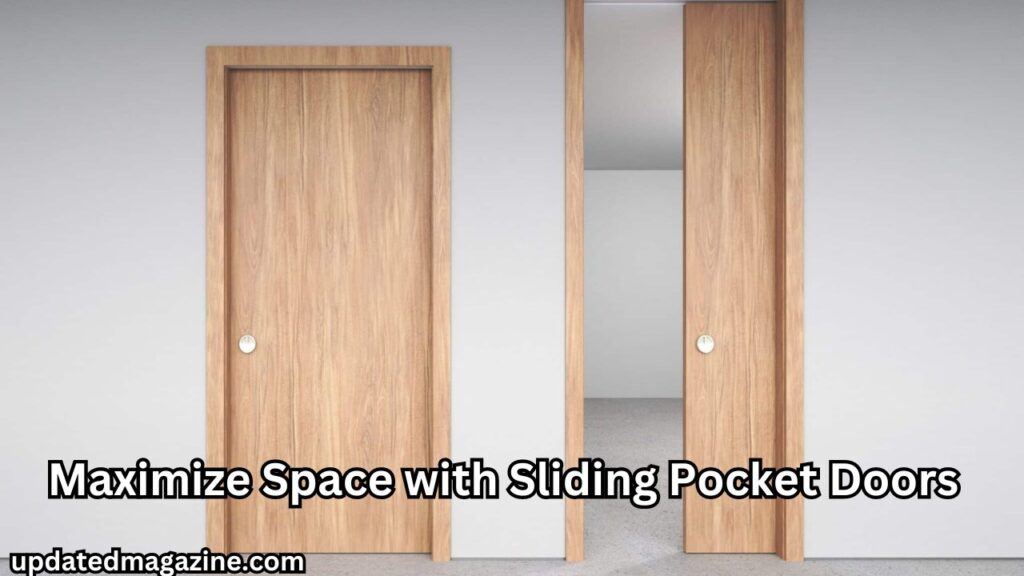In the world of modern home design, maximizing space and aesthetic appeal is paramount. One innovation that perfectly encapsulates these ideals is the pocket door. Unlike traditional hinged doors that require significant floor space to open, pocket doors slide effortlessly into the wall, offering a seamless blend of functionality and style. This article delves into the myriad benefits, types, installation procedures, and maintenance tips for pocket doors, providing a comprehensive guide for homeowners looking to enhance their living spaces.
What is a Pocket Door?
A pocket door is a type of sliding door that, when opened, disappears into a compartment in the adjacent wall. This ingenious design frees up valuable floor space and offers a clean, unobtrusive look. Pocket doors are ideal for rooms where space is at a premium, such as bathrooms, closets, and small bedrooms, but they can also be used to create a flexible open-plan layout in larger spaces.
Benefits of Pocket Doors
Space-Saving Solution
One of the most significant advantages of pocket doors is their ability to save space. Traditional doors require a clear area for the door to swing open and closed, which can restrict furniture placement and flow within a room. Pocket doors eliminate this issue by sliding into the wall cavity, allowing homeowners to utilize every inch of their floor space efficiently.
Enhanced Aesthetic Appeal
Pocket doors offer a sleek, modern aesthetic that can complement a variety of interior styles. They can be customized with different materials, finishes, and designs to match the decor of any room. Whether you prefer the classic look of wooden doors or the contemporary feel of glass, pocket doors can enhance the visual appeal of your home.
Increased Home Value
Installing pocket doors can also increase the value of your home. Prospective buyers often appreciate the space-saving and stylish features of pocket doors, making your property more attractive in the real estate market. Additionally, high-quality pocket doors can be a selling point that sets your home apart from others.
Types of Pocket Doors
Single Pocket Door
A single pocket door is the most common type, consisting of one door panel that slides into a wall compartment. This type is perfect for smaller spaces like bathrooms or closets, where a traditional swinging door would take up too much room.
Double Pocket Door
Double pocket doors consist of two panels that slide into opposite wall compartments. They are ideal for larger openings, such as the entryway between a dining room and living room. Double pocket doors provide a grander entrance and can create a more open, spacious feel when fully opened.
Sliding Pocket Door
You can use sliding pocket doors in various applications, from residential homes to commercial spaces. Designers can configure them to slide along a track on the floor or ceiling, depending on the specific needs of the space. Sliding pocket doors are especially useful in areas with limited wall space.
Materials Used in Pocket Doors
Wooden Pocket Doors
Wooden pocket doors are a popular choice due to their versatility and timeless appeal. They can be crafted from various types of wood, including oak, mahogany, and pine, and can be stained or painted to match your decor. Wooden doors offer a warm, natural look that suits both traditional and modern interiors.
Glass Pocket Doors
Glass pocket doors are ideal for spaces where you want to maintain an open, airy feel while still providing separation. They can be frosted or clear, depending on your privacy needs. Glass doors are often used in bathrooms, home offices, and modern living spaces to create a sleek, contemporary look.
Metal Pocket Doors
Metal pocket doors are less common but can provide a unique, industrial aesthetic. They are typically made from materials like aluminum or steel and are highly durable. Metal doors are an excellent choice for loft apartments or modern homes with an industrial design theme.
Installation of Pocket Doors
Pre-Installation Considerations
Before installing a pocket door, there are several factors to consider. First, ensure that your wall structure can accommodate a pocket door. This may involve checking for plumbing or electrical wiring that could interfere with the door cavity. Additionally, consider the door’s weight and the strength of the wall framing to ensure it can support the door.
Step-by-Step Installation Guide
- Prepare the Wall: Begin by removing the existing door and door frame. You’ll need to create an opening in the wall large enough to accommodate the pocket door frame.
- Install the Frame: Assemble and install the pocket door frame according to the manufacturer’s instructions. Ensure it is level and securely attached to the wall studs.
- Install the Track and Rollers: Attach the track to the top of the door frame and install the rollers on the door panel. The door should slide smoothly along the track.
- Hang the Door: Hang the door on the track and adjust the rollers as needed to ensure the door slides smoothly and aligns correctly with the door opening.
- Finish the Wall: Once the door is installed and functioning correctly, finish the wall by installing drywall over the pocket door frame and painting or decorating as desired.
Common Installation Mistakes
Avoiding common installation mistakes can save time and frustration. Ensure the frame is level and securely attached to the wall studs. Incorrectly aligned tracks can cause the door to bind or come off the track. Additionally, make sure the wall cavity is free of obstructions that could interfere with the door’s movement.
Pocket Door Hardware
Tracks and Rollers
The quality of the tracks and rollers is crucial for the smooth operation of a pocket door. Choose high-quality hardware that can support the weight of your door and provide smooth, quiet operation. Regularly check the tracks and rollers for signs of wear and lubricate them as needed to maintain optimal performance.
Handles and Locks
Pocket doors require specialized handles and locks. Choose handles that are flush with the door to allow it to slide fully into the wall cavity. For privacy, such as in bathrooms, consider installing a pocket door lock. Various styles are available, from simple latches to more sophisticated locking mechanisms.
Fouad WhatsApp offers numerous features that enhance the messaging experience. However, users must navigate the associated risks carefully. By staying informed and making cautious choices, you can enjoy all the benefits while minimizing potential drawbacks.
Maintaining Your Pocket Door
Regular Cleaning Tips
Regular cleaning is essential to keep your pocket door looking and functioning its best. Dust the tracks and rollers to prevent dirt and debris from causing the door to stick. Clean the door surface with a suitable cleaner for the material, such as wood polish for wooden doors or glass cleaner for glass doors.
Addressing Common Issues
Pocket doors can sometimes develop issues such as sticking, misalignment, or noise. Regular maintenance can prevent these problems. If the door becomes misaligned, check the tracks and rollers for wear and make necessary adjustments. For noisy doors, lubricate the rollers and track to reduce friction.
Pocket Door
A pocket door is a space-saving and stylish addition to any home. It slides into a compartment within the wall, freeing up floor space and creating a clean, modern look. Whether you choose a wooden, glass, or metal pocket door, its functionality and aesthetic appeal make it a worthwhile investment for any homeowner.
Conclusion
Pocket doors are an excellent solution for homeowners looking to save space and enhance the aesthetic appeal of their homes. With various styles and materials to choose from, these doors offer flexibility and customization to match any interior design. Whether you opt for the timeless charm of wooden doors, the sleek modernity of glass, or the rugged industrial look of metal, pocket doors provide a functional and stylish addition to any room.
The installation process, while requiring some carpentry skills, is manageable with the right tools and instructions. Paying attention to pre-installation considerations and following a step-by-step guide can ensure a successful installation. Additionally, choosing high-quality hardware, such as tracks, rollers, and handles, will contribute to the long-term functionality and smooth operation of your pocket door.
Maintaining your pocket door involves regular cleaning and addressing common issues promptly. Keeping the tracks and rollers free of debris and ensuring all moving parts are well-lubricated will prevent most operational problems. For homeowners looking to maximize their living space without sacrificing style, pocket doors are a compelling option.
ALso Read: GitHub.io Games: The Ultimate Guide
Frequently Asked Questions
What are the main benefits of a pocket door?
Pocket doors save space, enhance aesthetic appeal, and can increase home value. They are perfect for small spaces and can be customized to match various interior designs.
Can I install a pocket door myself?
Yes, with the right tools and instructions, you can install a pocket door yourself. However, it requires some carpentry skills and knowledge of your home’s wall structure.
Are pocket doors durable?
Yes, pocket doors can be very durable, especially when made from high-quality materials and properly maintained. Regular cleaning and lubrication of the tracks and rollers will ensure smooth operation.
What materials are best for pocket doors?
The best material depends on your needs and style preferences. Wooden doors offer a classic look, glass doors provide a modern, airy feel, and metal doors can add an industrial touch.
How do I maintain my pocket door?
Regularly clean the tracks and rollers, check for signs of wear, and lubricate moving parts as needed. Address any alignment issues promptly to prevent further problems.
Can pocket doors be locked?
Yes, pocket doors can be fitted with specialized locks, making them suitable for bathrooms, bedrooms, and other areas where privacy is needed.












